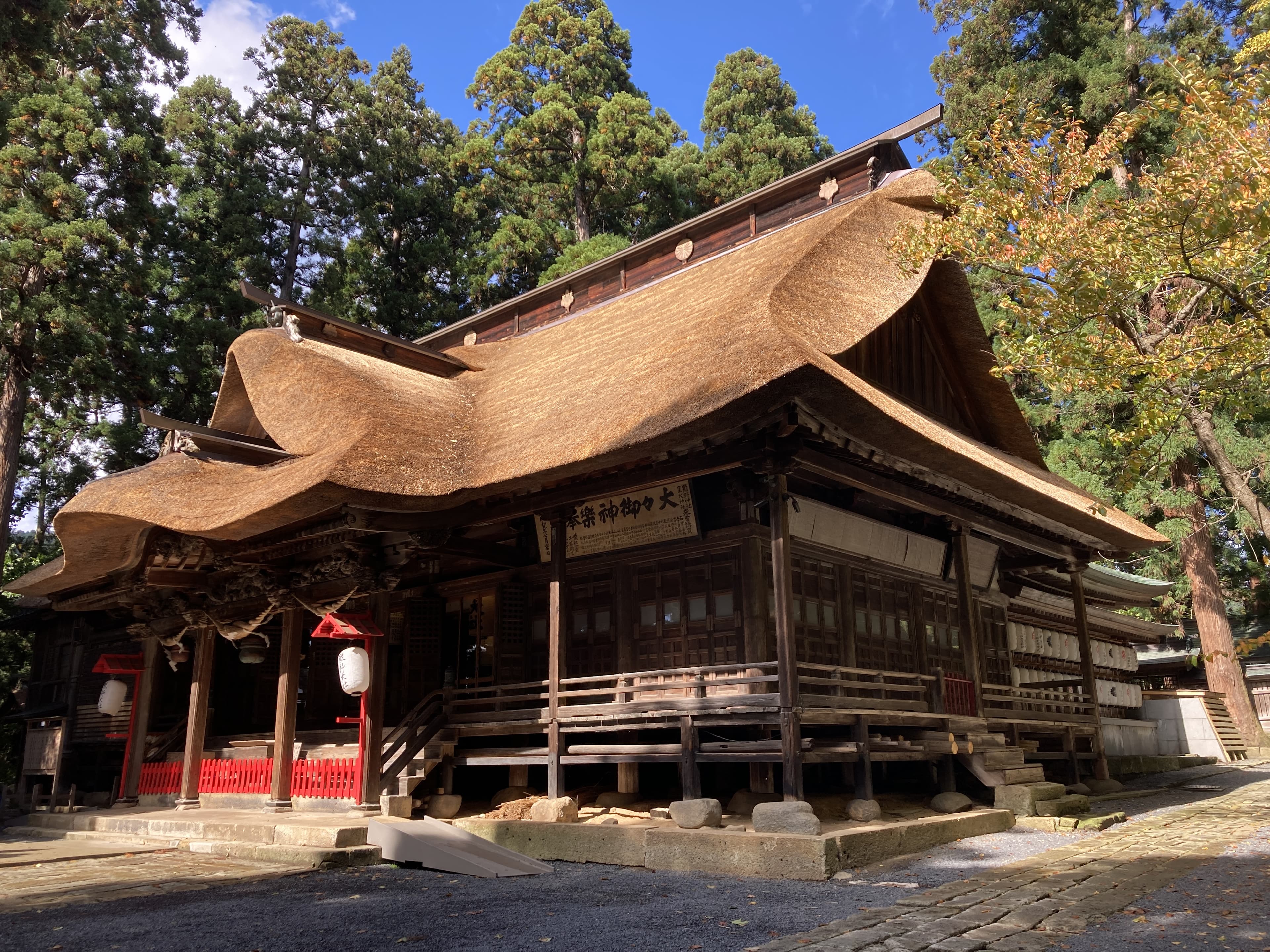
Kumano Taisha Shrine
熊野神社- Akayu StationŌu Main LineFlower Nagai Line
- 8 minutes bus drive to Miyauchi Station
- Walk 13 minutes
Kumano Taisha Shrine, located in the city of Nanyō, is one of the most significant spiritual sites in the Tōhoku region. With a documented history spanning over 1,200 years, the shrine is often referred to as the “Ise Shrine of the North”, a title that reflects its prominence and longstanding religious importance. Established in 806 AD, likely during the reign of Emperor Heizei, it has historically been supported by influential clans such as the Uesugi, Date, and Mogami.
The shrine is one of the three major Kumano Shrines in Japan, alongside Kumano Sanzan in Wakayama and Kumano Koutai in Nagano. It is nestled within a cedar forest at the foot of the mountains, offering a setting that embodies harmony with nature and the sacred. A particularly notable feature is an 850-year-old ginkgo tree standing near the approach path, especially admired during the autumn season when its golden leaves illuminate the grounds.
Deities Enshrined at Kumano Taisha
At the heart of Kumano Taisha's religious identity are its enshrined deities: Izanagi no Mikoto and Izanami no Mikoto. According to ancient Japanese mythology recorded in the Kojiki and Nihon Shoki, these are the first male and female gods to appear and unite. The element “izan” in their names comes from the verb izanau, meaning “to invite”, signifying their role as the gods who invited and accepted one another in mutual affection. Their simple and sincere exchange - “Ah, what a wonderful woman you are”, followed by “Ah, what a wonderful man you are” - is considered the first proposal in Japanese myth. These deities are deeply associated with love, harmony, and the act of creation, and they are worshipped at Kumano Taisha as the gods of marriage and matchmaking.
Within the shrine grounds, Izanami no Mikoto is enshrined under the name Kumano Fusumi no Ōkami, a deity embodying the power to generate all life. The word “Fusumi” is derived from musuhi, a term related to both birth and spirit. Izanagi no Mikoto appears as Kumano Hayatama no Ōkami, whose name suggests a soul filled with energy and vitality. Their offspring, Susanoo no Mikoto, is enshrined as Kumano Ketsumiko no Ōkami, a god associated with food and sustenance. Another important figure enshrined here is Yatagarasu, the mythical three-legged crow who, according to legend, guided Emperor Jimmu from Kumano to Yamato and is now worshipped as a deity of guidance and safe travel.
Hidden Rabbits and Flowing Architecture – Symbols of Mystery and Tradition at Kumano Taisha
A distinctive feature of Kumano Taisha is the presence of three hidden rabbit carvings located on the rear side of the main hall’s structure. These carvings are not marked or signposted, and it is believed that those who find all three without revealing the locations of the rabbits will be granted a wish or experience good fortune in love. This local belief has become one of the shrine’s most charming attractions, drawing visitors who quietly search the shrine’s wooden surfaces in hopes of discovering the rabbits on their own.
The main hall of the shrine is built in the traditional nagare-zukuri style, the most widespread architectural style for Shinto shrines in Japan. Characterized by its asymmetrical gabled roof that extends gracefully over the front entrance, the building reflects architectural ideals of simplicity and harmony with the natural environment. It is slightly elevated and constructed with unpainted cypress, emphasizing durability and elegance. The honden (main sanctuary) of Kumano Taisha is designated an Important Cultural Property of Yamagata Prefecture.
Traces of Syncretism – Where Shinto and Buddhism Meet
Kumano Taisha also preserves remnants of the syncretic fusion between Shintoism and Buddhism that was common in Japan before the Meiji era. The main hall once housed a hidden statue of Amida Nyorai, the Buddha who saves sentient beings and guides them to paradise. This statue, regarded as a manifestation or gongen of Kumano’s deity, represented the compassionate side of divine love, especially as it relates to sorrow and longing. Other Buddhist elements preserved at the shrine include statues of Kannon and Yakushi Nyorai - deities associated with mercy and healing - as well as a Muromachi-period portable shrine linked to Zenkoji Temple, Buddhist ritual decorations such as keman, and votive plaques featuring images of the Buddha. These artifacts illustrate the historical coexistence of Buddhist and Shinto belief systems at this site.
Guardians of Time – Sculptures from the Muromachi Period
A number of Muromachi-era guardian lions and dogs are also found on the grounds. One pair represents the cosmic sounds “ah” and “un”, symbolising the beginning and end of all things, while another set, finely carved with visible claws and expressive faces, shows the transition in style from the Kamakura to Muromachi periods. These figures were traditionally placed at separate halls but are now housed together, reflecting the architectural and religious shifts the shrine has undergone over the centuries.
Kumano Taisha is more than a regional religious site - it is a cultural institution that continues to offer a space for prayer, contemplation, and the quiet appreciation of myth and craftsmanship. Whether one visits to admire its ancient woods and traditional buildings, to search for the hidden rabbits, or to reflect on the meaning of connection and love, Kumano Taisha offers a deeply rooted and authentic experience of Japan’s sacred past.
At Hey Japan!, we strive to keep the places listed on our website as current as possible. However, it is important to note that location owners or management may make changes to their plans, including canceling events, altering opening times, or modifying admission requirements, without prior notice. To ensure that you have the most accurate information, we recommend checking official websites before visiting any location.
Last Updated:














